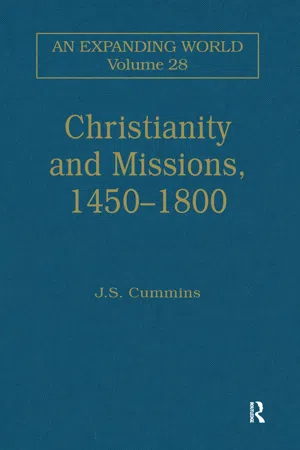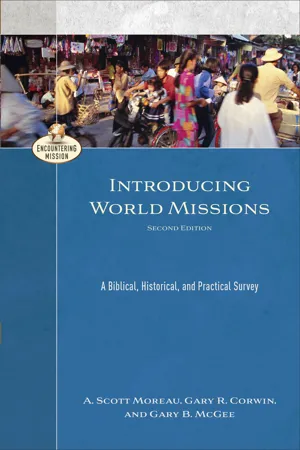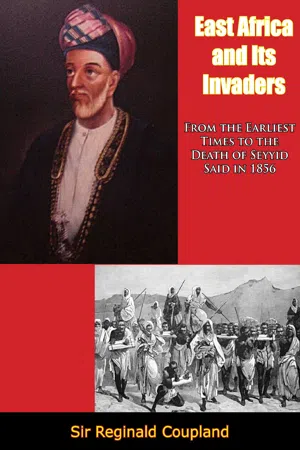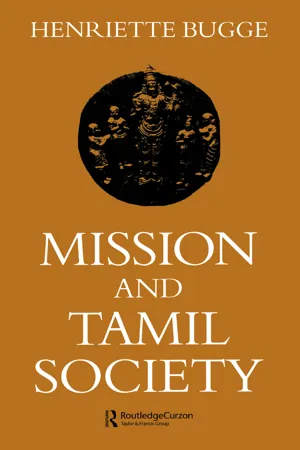History
Portuguese Missionaries
Portuguese missionaries were religious individuals sent by Portugal to spread Christianity in various parts of the world, particularly during the Age of Discovery. They played a significant role in the expansion of the Portuguese Empire and the spread of Catholicism, establishing missions, schools, and churches in regions such as Africa, Asia, and the Americas. Their efforts had a lasting impact on the cultures and societies they encountered.
Written by Perlego with AI-assistance
Related key terms
Related key terms
1 of 4
Related key terms
1 of 3
5 Key excerpts on "Portuguese Missionaries"
- eBook - ePub
- J. S. Cummins(Author)
- 2016(Publication Date)
- Routledge(Publisher)
8 The Problem of the Native Clergy in the Portuguese and Spanish Empires from the Sixteenth to the Eighteenth Centuries C.R. BoxerALBARNED Jesuit historian of the Japan mission recently observed: ‘The aim of Christian missionary activity in A every mission land is to establish the Church. The goal of the foreign missionary is primarily to prepare the ground and lay the foundation of the future Church. What he envisages, therefore, is the idea of a fully matured hierarchy of native-born bishops and priests capable of carrying on the work of the Church without foreign assistance.’1Identical sentiments have been voiced by other erudite Jesuit historians of Portuguese India and the Spanish Philippines; but their own well-documented works show very clearly that, however much this was a consummation devoutly to be wished, the road to its achievement was a long and an arduous one. Indeed, at times this objective was actively opposed by those very missionaries who should have been most anxious to attain it. Whatever the theory may have been, in practice the indigenous clergy were apt to be kept in a strictly subordinate condition to the European priests, particularly where these latter were members of the Regular clergy. How this discrimination arose, and the length of time for which it endured, is the theme of this paper.As a result of the Portuguese voyages of discovery round the African coast and the opening of the sea-route to India, a number of West Africans had been taken to Lisbon, where some of them received a religious training and education. Very few of them seem to have returned to their respective homelands as priests or as catechists; although one who did so was a Lisbon-educated Congolese ordained as titular Bishop of Utica in 1518, at the insistence of King Manuel of Portugal. This precedent of a Negro bishop was not followed for several centuries; but a papal brief dated 12 June of the same year authorized the royal chaplain at Lisbon to ordain ‘Ethiopians, Indians, and Africans’ who might reach the moral and educational standards required for the priesthood. The first step was thus taken towards the formation of a native clergy, but a good many years elapsed before matters proceeded much further. The projected evangelization of the old Kingdom of Congo foundered after a promising start, largely owing to the greater attractions of the West African slave trade, and to the tropical diseases which decimated the missionary personnel and militated against continuity of effort. - eBook - ePub
Introducing World Missions (Encountering Mission)
A Biblical, Historical, and Practical Survey
- Moreau, A. Scott, Corwin, Gary R., McGee, Gary B., Moreau, A. Scott(Authors)
- 2015(Publication Date)
- Baker Academic(Publisher)
Help also came from Rome. To condemn the notion of the indigenes as “dumb brutes created for [the Europeans’] service, pretending that they are incapable of receiving the catholic faith,” Pope Paul III declared in 1537 that the “Indians are truly men,” capable of conversion and instruction (Barry 1985, 599). Such notable strides in promoting human rights, however, made little difference in the lives of African slaves, since both colonialists and clergy purchased them to work on their sugar and tobacco plantations. The religious orders, including the Jesuits, who worked strenuously to combat the slavery of the locals, generally exhibited little interest in evangelizing them (Lippy, Choquette, and Poole 1992, 70). Exceptions included the Jesuit Peter Claver, who worked in the coastal port of Cartagena, Colombia, feeding and providing health care for newly arriving Africans.The Royal Patronages of Spain and Portugal brought the larger part of the Western Hemisphere under the umbrella of Christendom. Populations scattered across vast areas separated by steep mountain ranges and rain forests, combined with the continuing shortage of missionaries and the general refusal to ordain a native clergy, ensured that Christianity would be only a surface-level phenomenon in many places. The traditional religions still thrived in remote places and in modified forms under a Christian veneer, a state of affairs illustrated by the significantly different meanings attached by Spaniards and Mexican indigenes to the reported apparition of the Virgin Mary at Guadalupe in 1531 (Lippy, Choquette, and Poole 1992, 46).East of the line of demarcation, the Portuguese admiral Vasco da Gama reached the western coast of India in May 1498 after a long passage around Africa that outflanked the Muslim traders. The colony of Goa became the command center for the Portuguese Empire in the East. Home to magnificent churches, the city of Goa became known as the “Rome of the East” (Mundadan 1989, 436), with its archbishop assigned a diocese that stretched from Mozambique on the southeast coast of Africa to India, China, and Japan.Since Portugal preferred trade to empire building, the extent of its territories in Asia remained small, with the most important settlements being Goa, the Malaysian port of Malacca, the Chinese port of Macau, and the island of Timor. Not surprisingly, conflict in gaining access to markets and repulsing the attacks of unfriendly local rulers often required the use of force. “The two swords of the civil and the ecclesiastical power were always . . . close together in the conquest of the East,” wrote a Portuguese Franciscan in 1638. “For the weapons only conquered through the right that the preaching of the Gospel gave them, and the preaching was only of some use when it was accompanied and protected by the weapons” (Boxer 1978, 75). These colonies, along with the Philippines, represented the small-scale planting of Christendom in Asia. - eBook - ePub
Christians and Christianity in India and Pakistan
A General Survey of the Progress of Christianity in India from Apostolic Times to the Present Day
- P. Thomas(Author)
- 2020(Publication Date)
- Routledge(Publisher)
Padroado by which the Portuguese obtained certain ecclesiastical rights over the Christians and Churches in the East, which was later to cause infinite trouble to the Pope himself. This was yet to come, with the decay of the Portuguese power and the rise of other European nations. For the present we are concerned only with the phenomenal rise of Portuguese power in the East and their Christian zeal. Wherever the Portuguese flag flew, missionaries burning with zeal for the spread of Christianity appeared. The state actively supported the church and where the reasonable persuasion of the missionary failed to impress the arms of the state did.Vasco da Gama’s own chaplain, Dom Pedro de Covilham, of the Order of Redemption of Captives, was the first Portuguese missionary who was martyred in India. In 1510 the great Portuguese Admiral Albuquerque conquered Goa and rebuilt the city and made it the capital of the Portuguese Empire in the East. The earlier settlements of Cranganoor, Cochin and Calicut on the West Coast became subordinate to Goa and this city quickly rose to wealth and fame and passed into European legend as Golden Goa, the fabulous city of oriental splendour and luxury.Goa was not only the metropolis of political and civil authority of Portuguese Empire in the East but also the headquarters of Ecclesiastical authority and missionary activities. In 1534 Goa was raised to a Bishopric and in 1557 to an Archdiocese with Cochin and Malacca as suffragans; the Inquisition was established in 1560.The Franciscans and Dominicans were the pioneers in missionary work in Portuguese India. Within a short period they brought the majority of the population of the city of Goa under Christian influence. Their work extended to Cochin, Cranganoor and along the Coast as far as Mylapore. The greatest of their gains was, however, in the Fishery Coast where their work led to far reaching political consequences. An incident similar to the ‘War of Jenkin’s ear’ brought about a revolutionary change in the political and religious atmosphere of the Fishery Coast and led to the naval action of Vedalai which broke the Arab power on the West Coast. The incident deserves some detailed notice. - eBook - ePub
East Africa and Its Invaders
From the Earliest Times to the Death of Seyyid Said in 1856
- Sir Reginald Coupland(Author)
- 2018(Publication Date)
- Muriwai Books(Publisher)
The exploration, similarly, of Delagoa Bay in 1544 was not followed up. No settlement, no ‘factory’, was established here, nor any attempt made to open up another route to the goldfields. The Portuguese occupation of East Africa in fact extended very little farther than the Arab occupation. The Portuguese conquest was only a conquest of the Arab colonies. Like the Arabs, the Portuguese absorbed the local Africans of the coast as a lower caste of their colonial society. Since Portuguese women rarely emigrated, there was a similar, perhaps more frequent, mingling of blood; and a similar half-breed population rapidly grew up. But the tribes of the interior remained just as little affected by the coming of the Portuguese as they had been by the coming of the Arabs. The new invaders left them undisturbed and independent. Only their trade was wanted, and the pursuit of that was permitted readily enough by the leading chiefs in return for regular gifts of cloth and beads and bangles. There were quarrels, of course, at times, and occasionally fighting. The fort at Sofala was unsuccessfully attacked in 1506. A small Portuguese force was cut up near Mozambique about 1580. But peaceful, if not friendly, relations seem to have been the rule, mainly, no doubt, because there was so little contact. Portuguese explorers or prospectors did not venture far inland. No organized attempt was made to penetrate the continent till the end of the eighteenth century. Only, indeed, in the cause of their faith were the Portuguese more enterprising than the Arabs. The first Christian mission to the people of East Africa was undertaken by the Jesuits in 1560. They made their way to the court of the paramount chief of the Makalanga inland beyond Manika, but in 1561 their leader, Gonzalo da Silveira, was murdered, and in 1562 the mission was abandoned. The Dominicans followed, planting stations on the coast and up the Zambesi Valley. But with all their patience and courage—and there were Dominican as well as Jesuit martyrs—the missionaries made scarcely more impression on East Africa than the soldiers and the merchants.Thus the Portuguese invasion of East Africa, though the time of it was Portugal’s golden age, had little positive results, political or economic. Its chief historical importance lies in the bare fact that it gave the Portuguese a hold upon a section of the coast which they have never since lost. Of the rest of Albuquerque’s empire, all or almost all was soon to pass into other hands. The decline of Portugal after its annexation by Philip II of Spain in 1580 coincided with the invasion of the East by rival European peoples along the sea-way Portugal had opened; and in the course of the next century the Portuguese were robbed of all their eastern realm except one or two ports in the Indies and that fever-ridden stretch of African coastland between Cape Delgado and Delagoa Bay.3
The first French ship rounded the Cape of Good Hope in 1529, forty-three years later than Diaz; the first English ship in 1580, homeward bound on Drake’s world-voyage; the first Dutch ship in 1595. French overseas enterprise was engaged for a time elsewhere, but the Dutch and the English, like the Portuguese before them, proceeded from discovery to reconnaissance and from reconnaissance to organized attack. Covilhão’s work was done again and far more thoroughly by Linschoten, and the publication of his survey of Eastern lands and seas in 1596 was followed by a series of small Dutch expeditions and in 1602 by the foundation of the Dutch East India Company. Englishmen, similarly, like Stephens and Fitch, revealed to London merchants the golden prospects of eastern trade: in 1591 Lancaster, with ‘three tall ships’, was sent to India by da Gama’s East African route: and in 1600 the English East India Company was founded. Thereafter, both from England and from the Netherlands, armed trading-fleets were regularly sailing east and spreading out over the whole commercial sphere from the Red Sea to the Philippines. Under this double impact the Portuguese collapsed. One or two important footholds, such as Goa and Malacca, they retained; but they were driven from Hormuz by the Persians with English aid in 1622, and by 1650 they had ceased to be serious competitors in any field of eastern trade. The only real rivals thenceforward were the Dutch and the English and presently the French, and for a century a long three-sided contest for supremacy went on. At first the Dutch had easily headed the English in all areas. They had planted colonial settlements at Mauritius{62} - eBook - ePub
Mission and Tamil Society
Social and Religious Change in South India (1840-1900)
- Henriette Bugge(Author)
- 2020(Publication Date)
- Routledge(Publisher)
Only a few missionaries arrived in India at this time, mainly from the Franciscan and Dominican orders, and not until the establishment of the Diocese of Goa in 1534 were these missionaries organized in a unified missionary enterprise. The Portuguese civil and ecclesiastical authorities in Goa did not embark on any form of ‘internal’ (i.e. local) missionary activity either but accepted marriages between Portuguese soldiers and Indian women, and received the children of these unions into the Roman Catholic church. The relationship with the Syrian Christians was cordial and even extended to providing sums for the adornment of Syrian churches. 4 In the 1530s the Portuguese sent out their first missionaries in a combined attempt to place influential local groups in a position of allegiance to the Portuguese crown and to spread the Gospel. The following decade saw further attempts by the Portuguese to impose a joint civil and ecclesiastical regime not just in the Travancore-Cochin-Goa area but in the entire South Indian peninsula. The most interesting for our purposes is the excavation of the tomb of St. Thomas in Mylapore and the establishment there of a pilgrimage centre not controlled by the Syrian Christians. In other areas as well the Portuguese established pilgrimage centres, thereby falling neatly into the well-known South Indian tradition of kingship with its emphasis on military power and endowments of holy places. 5 The Counter-Reformation in Europe also had repercussions in South India. Most significantly the Counter-Reformation resulted in growing attempts to control the Syrian Christians and to bring them back to the Roman Catholic church. This was done either indirectly (by reserving jobs in the government only for Roman Catholic Christians) or more directly (by the introduction of the Inquisition in 1560)
Index pages curate the most relevant extracts from our library of academic textbooks. They’ve been created using an in-house natural language model (NLM), each adding context and meaning to key research topics.
Explore more topic indexes
Explore more topic indexes
1 of 6
Explore more topic indexes
1 of 4




